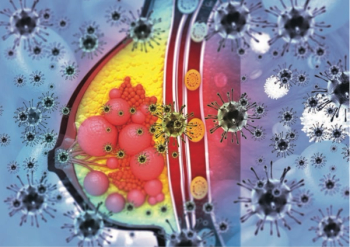
FDA Approves Taletrectinib in ROS1+ NSCLC

Supporting results for the approval of taletrectinib in ROS1+ NSCLC come from the TRUST-I and TRUST-II trials.
The FDA has approved taletrectinib (Ibtrozi) for patients with locally advanced or metastatic ROS1-positive non–small cell lung cancer (NSCLC), according to a press release from the agency.1
The approval is based on results from the phase 2 TRUST-I trial (NCT04395677) and the phase 2 TRUST-II trial (NCT04919811). Additionally, results were presented at the
Topline data showed that in patients with no prior treatment, the objective response rate (ORR) was 90% (95% CI, 83%-95%) in TRUST-I compared with 85% (95% CI, 73%-93%) in TRUST-II, with 72% and 63% experiencing responses for at least 6 months. Among those with pretreated disease, the respective ORRs were 52% (95% CI, 39%-64%) and 62% (95% CI, 46%-75%) in each study population; 74% and 83% of patients with a response had responses lasting for a minimum of 6 months.
The TRUST-I trial enrolled patients in China who had no prior tyrosine kinase inhibitor (TKI) therapy or had received prior treatment with crizotinib (Xalkori). The TRUST-II trial enrolled patients who were TKI-naïve and had received prior treatment with crizotinib or entrectinib (Rozlytrek).
For patients who received prior chemotherapy, the ORR was 87.5% (95% CI, 71.0%-96.4%) vs 89.1% (95% CI, 82.3%-93.9%) for those who did not receive chemotherapy. For patients who experienced a CR, the median duration of response (DOR) was 44.2 months (95% CI, 30.4-not reached [NR]), and the estimated 36-month DOR rate was 57.7% (95% CI, 45.0%-68.5%).
The median progression-free survival (PFS) was 45.6 months (95% CI, 29.0-NR), and the estimated 12-month PFS rate was 39.7% (95% CI, 29.6%-49.6%). The median OS was NR, and the estimated 12-month OS rate was 77.5% (95% CI, 68.1%-84.5%).
The intracranial ORR for patients who were TKI-naïve was 76.5% (95% CI, 50.1%-93.2%), the DCR was 88.2% (95% CI, 63.6%-98.5%), and the median DOR was 14.7 months (95% CI, 4.2-30.2). For those pretreated with TKIs, the intracranial ORR was 65.6% (95% CI, 46.8%-81.4%), with a DCR of 93.8% (95% CI, 79.2%-99.2%) and a median DOR of 11.9 months (95% CI, 6.9-23.5).
Additional results presented at ASCO showed that the cORR in the TRUST-I and TRUST-II trials among patients who were TKI-naïve was 90.3% vs 85.2% (RR, 0.94; 95% CI, 0.83-1.07); for those who had prior chemotherapy, it was 85.0% vs 90.0% (RR, 1.06; 95% CI, 0.80-1.40); and for those without prior chemotherapy, it was 91.6% vs 84.1% (RR, 0.92; 95% CI, 0.80-1.06). For those who were pretreated with TKIs, the cORR was 51.5% vs 61.7% (RR, 1.20; 95% CI, 0.87-1.66); for those with prior chemotherapy, it was 43.5% vs 78.9% (RR, 1.82; 95% CI, 1.08-3.06); and for those without prior chemotherapy, it was 55.8% vs 50.0% (RR, 0.90; 95% CI, 0.57-1.41).
The cORR was also comparable across race and region between the 2 trials. For those who were Asian and TKI-naïve, the cORR was 89.1% vs 84.2% for those who were non-Asian (RR, 0.94; 95% CI, 0.77-1.16); the cORR was 83.3% vs 100% for those who received prior chemotherapy (RR, 1.20; 95% CI, 1.00-1.44); and for those without prior chemotherapy, it was 90.4% vs 76.9% (RR, 0.85; 95% CI, 0.63-1.15). For those who were pretreated with TKIs, the cORR was 53.4% vs 64.0% (RR, 1.20; 95% CI, 0.84-1.71); with prior chemotherapy, it was 53.1% vs 80.0% (RR, 1.51; 95% CI, 0.96-2.36); and without chemotherapy, it was 53.6% vs 53.3% (RR, 1.00; 95% CI, 0.58-1.70).
For those who lived in non-Western areas and were TKI-naïve, the cORR was 89.7% vs 81.0% for those in Western areas (RR, 0.90; 95% CI, 0.73-1.12), 83.3% vs 100% (RR, 1.20; 95% CI, 1.00-1.44) for those with prior chemotherapy, and 91.1% vs 73.3% (RR, 0.81; 95% CI, 0.59-1.10) for those without prior chemotherapy. For those who were TKI-pretreated, the cORR was 52.9% vs 65.4% overall (RR, 1.24; 95% CI, 0.88-1.74), 53.1% vs 80.0% (RR, 1.51; 95% CI, 0.96-2.36) in those who had prior chemotherapy, and 52.7% vs 56.3% (RR, 1.07; 95% CI, 0.65-1.76) in those who did not have prior chemotherapy.
Grade 3 or higher treatment-emergent adverse effects (TEAEs) occurred in 54.3% vs 52.6% in the TRUST-I and TRUST-II trials, respectively (RR, 0.97; 95% CI, 0.80-1.18). Grade 3 or higher alanine transaminase (ALT) or aspartate transaminase (AST) elevation occurred in 20.2% vs 18.1% (RR, 0.90; 95% CI, 0.58-1.38), and grade 3 or higher gastrointestinal (GI) disorders occurred in 5.8% vs 4.1% (RR, 0.71; 95% CI, 0.28-1.82).
For those who were Asian, grade 3 or higher TEAEs were observed in 53.0% of patients vs 54.9% who were not Asian (RR, 1.04; 95% CI, 0.83-1.29), AST/ALT elevation in 18.6% vs 20.9% (RR, 1.12; 95% CI, 0.70-1.81), and GI disorders in 4.7% vs 5.5% (RR, 1.16; 95% CI, 0.42-3.20).
For those who lived in non-Western areas, grade 3 or higher TEAEs were observed in 52.6% vs 55.7% who lived in Western areas (RR, 1.06; 95% CI, 0.85-1.31), ALT/AST elevation was observed in 18.6% vs 20.6% (RR, 1.11; 95% CI, 0.69-1.77), and GI disorders occurred in 4.9% vs 5.2% (RR, 1.06; 95% CI, 0.38-2.93).
The
References
- FDA approves taletrectinib for ROS1-positive non-small cell lung cancer. News release. FDA. June 11, 2025. Accessed June 1, 2025. https://tinyurl.com/yc4f379m
- Pérol M, Li W, Pennell NA, et al. Comparable efficacy and safety of taletrectinib for advanced ROS1+ non–small cell lung cancer across pivotal studies and between races and world regions. J Clin Oncol. 2025;43(16). doi:10.1200/JCO.2025.43.16_suppl.8643
- Pérol M, Li W, Pennell NA, et al. Taletrectinib in ROS1+ non-small cell lung cancer: TRUST. J Clin Oncol. Published online April 3, 2025. doi:10.1200/JCO-25-00275
- U.S. Food and Drug Administration accepts for priority review Nuvation Bio’s new drug application for taletrectinib for the treatment of advanced ROS1-positive non-small cell lung cancer. News release. Nuvation Bio. December 23, 2024. Accessed June 10, 2025. https://tinyurl.com/bfty8jfw
Newsletter
Stay up to date on recent advances in the multidisciplinary approach to cancer.

















































































